Articles & Whitepapers
Crucial Insights into Business Travel Tracking
From crossing state lines to crossing international borders, a company’s Duty of Care obligation is a compelling reason alone to keep close track of employees on business travel.
Need another great reason? Tax compliance!
A Critical Commonality
Business travelers can span the full range of an organization’s company ladder, from C-suite executives, recruiters and salespeople to in-the-field technicians, drivers and interns visiting different facilities. Methods of employee travel will also consist of various forms of transport getting to a destination.
Once they arrive, however, all share a critical commonality: they and their employers are subject to the tax laws, rules, and regulations of the local jurisdictions where they work.
Companies typically differentiate “business travel” from “short-term assignments” based on the number of days an employee is expected to travel and be on the ground in a specific location. Yet, internal company policies or travel definitions might not fully or consistently address all destination tax obligations and/or reporting requirements.
As more nations and states seek to collect income tax on the earnings of visiting business travelers to increase tax revenue opportunities, tracking and reporting employee movement has become significant.
Recognizing Risks & Reducing Surprises
Employees and employers must carefully adhere to various requirements to allocate and report income and withhold and remit taxes on business travelers’ earnings, but the ability to provide consistent, comprehensive travel reports for analysis is an obstacle many companies still face internally.
An NEI global tax partner, Deloitte, points out that surprises can be reduced by 1) recognizing the risks emanating from a mobile workforce; and 2) working collaboratively to answer the following questions for further action:
- Who are the organization’s business travelers?
- In which jurisdictions are they working?
- What compliance obligations are generated?
Reporting on the whereabouts and business activities surrounding company business travelers is either frequently inconsistent or not addressed within most companies due, usually, to no specific group or stakeholder having the knowledge and capability to comply with the countless unique regulations by location.
Taking the lead to get one’s company in compliance – or in a better shape to comply – may seem a daunting task. The next question becomes who is best to lead the quest to answer the above three questions and proactively address the consequences of regulatory enforcement?
The answer will vary by company, but a senior executive sponsor is key for momentum, oversight and decision making, as is forming a cross-functional, collaborative team with members from Human Resources and Talent Management, Mobility, Payroll, Finance, Tax and Corporate Travel departments – those who understand the issues and can work together to mitigate risks.
Data In = Data Out
This collaborative team will be responsible to review the business analytics around travel data for improved compliance efforts, but what if available data is sparse or inconsistent?
Some companies may find it seriously challenging to generate required travel data and reports for analysis. In addition to understanding how travel details for each individual employee can be consistently obtained, the Global Tax Network, an NEI global tax partner, suggests that meaningful reports for analysis would need to show whether:
- Business travel actually was taken on all days indicated on the report.
- The employee used part of the time at the destination location for personal reasons.
- The employee booked a business trip outside of the company’s travel department.
- The employee listed on the report was the one who traveled or did another employee(s) travel in their place.
With technology advancements and departments sharing more information – such as travel and workday calendars, smartphone tracking apps, relocation travel reports, and more – the capability to track business travelers has come a long way compared to two-to-five years ago. This can prove helpful to track business travelers and analyze the data for risks.
Compliance Ready
Awareness of an employee’s work location and enforcement of business traveler compliance has become a more prominent issue since work-from-anywhere became popular and travel has increased again following a sharp COVID-related decline.
Despite increased administration costs and some initial hurdles, business travel compliance is much less stressful and costly than any noncompliance and expensive tax surprise consequences to either the employee or employer. Addressing business travel in such a manner also supports Duty of Care issues and knowing where all employees are should a crisis occur.
NEI understands there are many questions companies have and challenges faced when it comes to reporting for compliance regarding business trips, whether for tax, immigration, insurance, or countless other topics. If you would like to discuss business travel or other compliance trends, please contact your NEI representative.
The above article is provided for informational purposes only, and is not intended to provide, and should not be relied on for tax, legal, or accounting advice. Please consult your own tax, legal, and accounting advisors before making any decisions or transactions.
U.S. Renters' Housing Shortage
Renters make up a significant share of annual moves each year in the U.S. as they continue to be attracted to better weather, lower costs of living, stronger job prospects and/or wanting to be closer to family. Here is how it affects relocating employees.
Areas Most Impacted
There is a clear migration trend for renters:1
- More want to move out of the Northeast and West; and
- The South and Midwest remain popular destinations.
But key factors impact both those simply wanting to move and those relocating at the request of an employer: availability, competition, and affordability.
What reasons are behind this and what assistance is available for renters?
Availability
In most markets, the biggest challenge for renters moving is a serious shortage in available housing and an underbuilding gap of 5.5 million to 6.8 million units.2
Jeffery Hayward, Executive VP and Chief Administrative Officer at Fannie Mae, points out most housing-cost-burdened households are not just in coastal or metros, but also in less expensive metros – like Fresno, Charlotte, and Las Vegas. Even smaller metro areas lack housing that’s affordable.
Consider the following “availability” factors:
- Restrictive zoning increases the challenges nationally. Robert Dietz, Chief Economist at the National Association of Home Builders. "In certain neighborhoods you simply cannot build townhouses. You have to build single family units on lots that are bigger than the market wants." 3
- Institutional investors continue to purchase and rent out properties, owning about 700,000 of the 20 million single-family rentals in the U.S. today.4
- Renters also face the “Airbnb Effect” where landlords convert long-term rentals for local residents to short-term vacation housing, thus decreasing housing supply. A study found short-term rentals have caused a larger reduction in affordable housing than any other income level of rental housing.5
Competition and Affordability
An average of 14 apartment seekers competed for a single rental across the U.S., but it’s even more challenging around ultra-competitive areas. San Diego – the 13th most competitive apartment market in the nation – has an average of 22 apartment seekers competing for each of the few available apartments.6
Since COVID, renters also face higher monthly leases with an overall increase in rents of 6.2 percent in 2022, marking the second-highest annual rent growth in this century, according to Yardi Matrix’s multifamily report. That growth rate is behind only 2021’s nearly 15 percent rise.7
However, that growth rate is well behind the rent growths in popular markets. From November 2021 to November 2022:
- Chicago was among the most robust in the Midwest region with average rents rising by 8.6 percent - $1,773 to $1,925. 8
- Phoenix rents surged 26 percent.
- Las Vegas rents jumped 23 percent.
- Charlotte residents saw rents climb 13 percent.9
- Florida metro areas of Naples, Sarasota, and Tampa jumped between 29 percent and 39 percent the past two years.10
Renter Expectations, Experts and Effective Efforts
For companies that need to relocate employees to challenging rental markets, setting expectations in advance and pairing your people with the right local experts will result in the most effective efforts to compete for the best rental opportunities.
Expectations
- Relocating employees often must look farther out from a job site and accept longer commute times than years’ past – and may still have difficulties locating adequate housing.
- Managing renters’ expectations earlier is important: they need to know finding an apartment has become increasingly difficult and the type of housing they are accustomed to may now be beyond their budget.
Experts
- In the past, renters may have been offered only a lump sum and expected to make appropriate relocation decisions on their own. Such an approach rarely ends up working out well in the current environment given the competitive market and low housing availability.
- It is critical to work with local, on-the-ground experts who really know the rental market in each location. NEI is independent, so we can work with the most reputable and qualified rental agents, Destination Service Partners, and real estate brokers to preview potential apartments and rental homes before showing them.
Effective Efforts
Following a needs analysis, NEI’s Account Executives arrange for customized area orientation tours (if authorized) and provide access to our city search tool to acquaint themselves with the area before the home finding trip. Various service plans are available based on one’s program needs:
- NEI’s Home/Rental Finding Assistance minimizes time required for relocating employees to find suitable housing – whether as buyers or renters. We refer the families to reputable, qualified real estate brokers or rental agents to help in searching for their new home based upon specifics given through the initial needs analysis. NEI’s Rental Guide provides pertinent information to consider when leasing a property.
- Under NEI’s Extended Rental Assistance Program, we provide each agency with verbal and written instructions to anticipate the needs of employees, as well as clear expectations, required timelines and reporting requirements for the rental search. Our Account Executive follows up with the rental finding agent and calls the transferring employee after the initial contact, during, and just after the rental finding trips to ensure satisfaction. They remain in contact with the employee until a lease is finalized.
The Extended program may also include an area orientation tour to acquaint the employee with the new area and a guided tour of available rentals to quickly identify the most likely areas to meet the employee’s housing needs. Various service levels can be selected based on your program needs. This program is highly recommended for those moving to large, high cost of living areas.
Relief in Sight?
There could be good news for renters across the country in the months ahead:
- Rents for both single-family homes and apartments are rising at a slower pace as of December 2022, but relief rates vary by market.11
- Experts forecast an increase in the number of new homes, condos, and apartments coming to market. Apartment deliveries are projected to spike with more than 917,000 units under construction across the U.S. – the second largest volume increase the country has ever seen.12
- Home prices may decline in 2023 giving renters a potential window to purchase a home. Economists’ predictions for U.S home-sale prices run the spectrum for 2023: some feel it could remain stable and even re-bound again later this year, others expect a drop of 10 percent or more if there’s a sharp recession.
"This spike in prices in the short term should be followed by moving toward a new equilibrium, which does mean a bit of a cooldown in housing costs," senior economist at Zillow, Jeff Tucker.13
For more information on how NEI can help your company and your relocating renters in today’s volatile market, please reach out to your NEI representative.
This material has been prepared for informational purposes only, and is not intended to provide, and should not be relied on for, tax, legal or accounting advice. You should consult your own tax, legal and accounting advisors before engaging in any transaction.
1 Rent.com; 2 National Association of Realtors; 3 National Public Radio; 4 Roofstock.com; 5 2021 Carnegie Mellon University; 6 RentCafe.com; 7 Yardi Matrix; 8 Zillow; 9 Douglas Elliman and Miller Samuel; 10 CoStar Group; 11 CNBC/CoreLogic; 12 RealPage Market Analytics; 13 USA Today.
NEI Global Relocation once again makes the HRO Today Baker’s Dozen for Relocation! NEI is one of only two companies to be recognized in the survey for at least 11 of the past 13 years, indicating strong consistency in satisfaction for the services provided to our clients and their relocating employees.
“We are very appreciative of our clients taking the time to participate in this survey,” said Randy Wilson, SCRP, President | CEO, NEI Global Relocation. “Time is precious, especially for today’s global mobility professionals. Our employees work very hard to ensure each relocating family has a positive experience and this type of recognition is important to see given the challenges we have all faced over the past two years.”
The Baker’s Dozen for Relocation is one of two annual industry surveys measuring client satisfaction among global mobility providers, the other one being the Trippel Relocation Managers’ Survey, which provides more overall detail. NEI is also a high performer in that survey, achieving more #1 rankings than any other relocation management company in each of the last three surveys.
API Integrations and Relocation - What You Should Know
API integrations for relocation are the future of working faster and more efficiently. As global mobility professionals face growing responsibilities and increasingly complex processes, workflow efficiencies become more important to meet your talent objectives.
That’s where API integrations demonstrate true value. APIs, or Application Programming Interfaces, create communication protocols between business systems, automate workflows and streamline processes within and outside your organization.
Automation drives efficiencies for HR Mobility teams, all who touch your mobility processes, and improves the overall experience of your relocating employees. Automated workflows allow your team members to focus on what is important – securing critical talent and getting them where they are needed as quickly as possible.
It also helps your business scale for future growth by leveraging technology.
UNITE Integration Platform
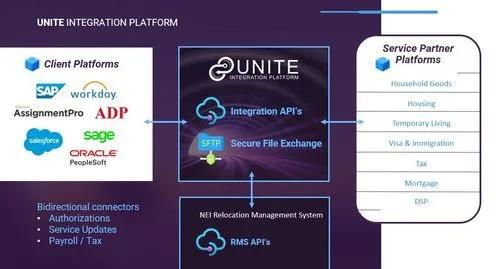
NEI's UNITE Integration Platform simplifies the integration process to easily connect client and supply chain partners within a highly efficient mobile workforce management system to:
- Seamlessly integrate systems and synchronize data between the client and NEI
- Automate entire business processes, including authorizations, relocation activities, invoicing, compensation, and tax gross-up
- Drive efficiencies and improve the overall experience of your relocating employees through the timely delivery of quality services
While technical staff are needed for API integrations, NEI’s UNITE Integration Platform minimizes the one-time investment to create efficiencies throughout your relocation lifecycle. This investment pays long-term dividends, freeing up time and energy for what matters most - getting the right people in place to unlock new business capabilities for your company.
In Summary
As a full-service global mobility company offering related global compensation and consulting services, NEI Global Relocation (NEI) uses UNITE to unify the entire relocation experience.
Innovation through API integration is a strong focus toward our collaborative approach to provide trustworthy, consultative mobility solutions that make the relocation process work better, so you can achieve your talent agility objectives.
For more information on how UNITE can improve your workflows, please contact NEI Global Relocation.
NEI Service Partner Spotlight - IOR Global Services
Cultural training is a critical component of preparing for an assignment in a foreign country. Customs and communication styles can vary significantly and raising awareness of those differences can help relocating employees navigate the nuances of a new location.
In the linked infographic, you can see a glimpse of the type of information that is shared when working with one of our service partners, IOR Global Services. Click here for details.
New Travel Authorization Systems Postponed Again in U.S. and Europe
Enforcement of two new travel authorization systems have been postponed again in the U.S. and Europe:
- ETIAS (European Travel Information and Authorization System) – until 2024; and
- REAL ID – until May 2025
ETIAS Postponement
Europe receives over 37 million visitors each year, so the introduction of ETIAS – similar to the U.S. ESTA program (Electronic System for Travel Authorization registration system) – is expected to have a significant impact on travelers from around the world, including the global mobile workforce.
The roll-out for ETIAS has been planned for years, but the start date has been repeatedly pushed back from 2020, 2022 and 2023, to launch in 2024. There is speculation the new 2024 date could be pushed back further, perhaps after the Summer Olympics in Paris concludes on 10 August 2024.
Once implemented, all visitors who previously travelled visa-free to Europe’s Schengen Zone will be required to register in advance online. For European countries which will be using ETIAS starting 2024, please see click here. To register, individuals will need a passport valid for three months beyond the intended stay, an e-mail account, and a credit or debit card. Passengers will be required to complete an online application form that covers a range of biometric, travel and security related questions. Data will be checked against a variety of European and International databases including no fly lists, to identify potential terrorist and criminal threats who will then be refused entry via the ETIAS program.
When up and running, it is expected most ETIAS applications will take 20 minutes to complete, but time will vary based on additional fields one may need to fill out. Applications may be processed and delivered by e-mail within one hour if no further checks are required, but it could take upwards of 96 hours if additional information’s needed. An application fee will be €7, though travelers under the age of 18 or over the age of 70 will not need to pay a fee.
REAL ID Postponement
To help improve airline security, Congress passed the REAL ID Act in 2005 and the U.S. Transportation Security Administration and other federal agencies announced they would require REAL ID compliant licenses for people 18 years old and older to fly anywhere within the U.S. starting in May 2023.
However, the Department of Homeland Security announced the deadline would be extended until May 7, 2025 since state motor vehicle departments need more time to process the backlog of applications created by COVID-19 and only about 50 percent of the U.S. population has REAL ID compliant documentation.
Secure REAL ID will “set standards for the issuance of sources of identification, such as driver’s licenses” and will have a star at the top of the license. When enforced in 2025, it will be required for every air traveler 18 or older at airport security checkpoints for domestic travel. Those under 18 must be travelling with an individual who has acceptable documentation.
To get a REAL ID license, a person typically will need to show proof of their full legal name, date of birth, Social Security number, two proofs of residence and lawful status. Lawful status means that the person will need to provide valid documentary evidence that they are lawfully in the United States per Section 202.(c)(2)(B).
Still, despite REAL ID requirements, other documents may be substituted or used instead when enforcement starts in 2025. These may include U.S. passports, Department of Homeland Security-trusted traveler cards, U.S permanent residence cards, federally recognized tribal-issued photo IDs, and USCIS Employment Authorization Cards.
Costs will be tied to local fees associated with obtaining driver licenses or identification cards. Employers should encourage their employees to determine if their current identification includes the star. If not, it would be good to advise them to obtain the REAL ID designation to avoid unnecessary delays obtaining the necessary documentation for traveling by air by the 7 May 2025 start date.
Passport Processing Woes Persist
The Pandemic may be officially over, but U.S. citizens in need of a passport are facing increased challenges with passport processing times.
Millions in Backlog
During COVID, there was a government backlog of 1.7 million U.S. passport applications. Today, the U.S. State Department reports “unprecedented” delays in processing documents due to software and staffing issues with some three million applications now backlogged.
Though the Department issued a record 22 million passports in 2022, the weekly volume of applications so far this year is 30 to 40 percent higher than last year with an influx of about 500,000 new passport applications received each week now.
Before COVID, it took about four-to-six weeks to process a passport after receipt. Today, after receiving the application, new estimates for processing and issuing passports are more than three-to-four months. Mailing times can add additional weeks to a month and some people report receiving their passports five months after applying in the traditional manner and even four months after paying for an expedited service.
Further, many countries have "six-month passport rules," where they will not accept entry by travelers whose passports will expire less than six months after the beginning of their trip.
Prepare Extra Early
In addition to the current backlog, 23 percent of U.S. adults say they plan on traveling internationally this summer – up from 20 percent in 2022. For U.S. citizens planning international travel this year, whether it is personal or business related, if you need a passport preparation should begin well in advance to avoid delay.
Just how far in advance? A minimum of four to six months when using expedited shipping is recommended. Consider the following:
- Applicants should make certain details and supporting documents (like pictures and driver’s license) are 100 percent correct to avoid delays.
- If travel is this October or later, applying the traditional way is likely safe, but your application should be submitted immediately with expedited shipping.
- If travel is this August or September, one can potentially still get a passport in time, but will need to pay a fee to expedite processing as well as expedited shipping, but there is no guarantee.
Checking on Passport Status
You can check the status of an in-process application by visiting the U.S. Passport Application Status page. If there is a proven life-or-death emergency or urgent international travel coming up within 14 days, one can try making an in-person appointment at one of 26 passport agencies throughout the U.S., but an appointment to visit an agency is mandatory and the only way to make an appointment is by calling 1-877-487-2778 between 8 a.m. and 10 p.m. ET, Monday through Friday. Spaces are limited and agencies do not accept walk-in services.
Expediting Agencies
Expediting agencies are companies that assist with rushed passport applications and charge an additional fee on top of the standard passport application fee and expedited passport service fee. The fastest turnaround time is one week for $799 or a two-week option for $599, but even these can be limited in availability since expeditors rely on a subset of appointments being available.
In limited cases, expediting agencies may have extremely limited availability of next day or three day turnaround slots, but these are very few and often attract a much higher management fee from the agency according to EIG, one of NEI’s Visa and Immigration (V&I) service partners. There are various passport expediting agencies that offer these services, with each being allocated a certain number of faster appointments. So, if the agency first approached does not have any available appointments, it is worth checking with an alternative provider directly.
Newland Chase, another V&I service partner, suggested that companies may consider having their frequent business travelers obtain a secondary U.S. passport which would be valid for four years and could be quite helpful if an application is tied up in process and international travel is required.
NEI will continue to provide clients with updated information on this topic and manage relocating employees’ expectations accordingly. If you would like to discuss this passport situation further, please reach out to your NEI representative.
Canada's Relocation Property Rules Eased
On 1 January 2023, the Canadian Government imposed restrictions on non-Canadians from buying residences with the Prohibition on the Purchase of Residential Property by Non-Canadians Act, which prohibited relocating employees from purchasing a home in Canada until certain restrictions were met . We’re happy to provide some recent updates that have amended the situation.
After much lobbying from the Canadian Employee Relocation Council (CERC) and Worldwide ERC, Ahmed Hussen, Canada’s Minister of Housing and Diversity and Inclusion, announced amendments to the law that will help alleviate stress for anyone who is considering moving to Canada.
Updated Amendments
- Non-Canadian employees with a valid work permit who work in Canada for at least 183 days may now purchase a single home.
- The requirements for a non-Canadian investor owning equity in a private Canadian business was increased from 3 percent to 10 percent. Once the equity threshold has been met, these investors will also be able to purchase a home.
- Non-Canadians may now purchase property for development purposes, such as vacant lots, zoned for residential or mixed use.
“These amendments will allow newcomers to put down roots in Canada through home ownership and businesses to create jobs and build homes by adding to the housing supply in Canadian cities,” says Hussen.
Unfortunately, non-Canadian relocation management companies (RMCs) are still not able to acquire homes as part of a Guaranteed Buy Out or Buyer Value Option program.
NEI will continue to keep our clients updated with any further developments as they occur.
Nations Revamp Immigration for a Skilled Workforce
Global competition to attract top talent and skilled labor is heating up as countries look for every edge to attract the best foreign workers and students. To that end, countries are shifting immigration policies to favor the best candidates and help solve internal economic and demographic challenges.
Intense Country Competition
The 2023 Hiring & Workplace Trends Report produced jointly by companies Glassdoor and Indeed finds there will likely be a persistent tight supply of workers for years to come in key economic sectors and without sustained immigration, an increase in labor productivity or a focus on attracting workers, many industrialized countries will continue to struggle with a tight labor market.
Countries are implementing new programs to not only understand where new talent may come from, but also which countries’ talent pools they can best attract and then changing immigration requirements to support this.
Successful governments are implementing four key strategies to attract international talent, according to the Mauve Group, a provider of Global Business Solutions and Consultancy Services:
1. Introducing new work visas
2. Shifting immigration policies
3. Targeting incentives for specific occupation shortages
4. Offering financial incentives and better benefits
Consider this small sample of recent country-specific schemes to attract talent:
- The UK feels its High Potential Individual (HPI) visa route will attract the "brightest and best" early in their careers allowing identified talent permission to stay in the UK for at least two years.
- Hong Kong says its “Top Talent Pass Scheme” will raise its international competitiveness by offering them a two-year visa that allows them to work, establish a business or change employers in Hong Kong.
- Finland’s “Talent Boost” program aims to attract high-skilled workers from Vietnam, as well as Brazil, Turkey, and India.
- Canada’s New Brunswick province hosted recruitment sessions for candidates of specific countries, such as Nigeria, the United Arab Emirates, and Argentina.
- Bahrain’s Golden Residency Visa helps international workers stay in Bahrain permanently.
- The German government announced plans to make it easier for IT workers from India to obtain German work visas.
- The United Arab Emirates extended its Golden visa program to attract skilled foreign talent -- professionals, scientists, and researchers - to live, study, or work in UAE for 10 years.
Clearly, a post-pandemic global battle for talent and immigration shift is underway, one that will be critical to the future success of many countries as demographics and economies evolve.
Country Case Study: Japan
Every country’s immigration scheme has their own specific and highly unique details for candidates to qualify for entry and attention to details cannot be emphasized enough.
Consider the example of Japan, which ranked 41st of 63 economies in 2022 for attracting and retaining talent. To improve its position in the high-stakes global talent game, it recently introduced two new visas, the J-Skip and the J-Find:
- The “J-Skip” Visa, aimed at attracting special, highly skilled professionals to Japan.
- Requirements: Individuals who hold at least a master’s degree or 10 years’ relevant work experience with an annual income of 20 million JPY ($143,530 USD) or more can apply for either a Highly Skilled Professional (i)(a) - advanced academic research activity or a Highly Skilled Professional (i)(b) - advanced specialized/technical activity. Individuals with 5+ years of practical experience in business management with annual income of 40 million JPY ($287,060 USD) or more can apply for a Highly Skilled Professional (i)(c) Advanced business management activity.
- The “J-Find” Visa, designed for recent graduates of highly ranked universities to pursue job or entrepreneurship opportunities in Japan. They will be allowed to stay in Japan for up to two years for job hunting and preparation for starting a business. They can also accompany their dependents, such as spouses and children.
- Requirements: Status of residence will be granted by Japan to graduates of a university ranked in the top 100 of at least two of the following three World University rankings* within the last five years and have an amount of deposit and savings of at least 200,000 JPY ($1,435 USD) for living expenses when applying. * QS Top Universities, the Times Higher Education World University Rankings, and Shanghai Jiao Tong University’s Academic Ranking of World Universities.
Further supporting this effort and a talent pipeline, Japan’s Council for the Future of Education Creation also recently announced an initial proposal to further “internationalize” higher education with the goal of attracting over 400,000 foreign students from overseas institutions and encouraging them to work in Japan after they graduate.
Global Talent and Immigration Shift
It is clear countries will continue modifying visa and immigration laws to help boost their future economies and compete as popular destinations for global talent.
If you would like to discuss this or other immigration or global mobility trends or company needs, please contact your NEI representative.
The above article is provided for informational purposes only. Please consult your tax, legal, immigration or accounting advisors before making any decisions or transactions.
Travel Authorization Shifts
Enforcement of three new travel authorization systems have been postponed again in the U.S. and Europe:
- ETIAS (European Travel Information and Authorization System) – until 2024
- The UK’s ETA (Electronic Travel Authorization”) visa waiver – dates vary by county
- REAL ID – delayed until May 2025
ETIAS Postponement
Europe receives over 37 million visitors each year, so the introduction of ETIAS – similar to the U.S. ESTA program (Electronic System for Travel Authorization registration system) – is expected to have a significant impact on travelers from around the world, including the globally mobile workforce.
The roll-out for ETIAS has been planned for years, but the start date has been repeatedly pushed back from 2020, 2022 and 2023, to launch in 2024. There is speculation the new 2024 date could be pushed back further, perhaps after the Summer Olympics in Paris concludes on 10 August 2024.
Once implemented, all visitors who previously travelled visa-free to Europe’s Schengen Zone will be required to register in advance online. To register, individuals will need a passport valid for three months beyond the intended stay, an e-mail account, and a credit or debit card. Passengers will be required to complete an online application form that covers a range of biometric, travel and security related questions. Data will be checked against a variety of European and International databases including no fly lists, to identify potential terrorist and criminal threats who will then be refused entry via the ETIAS program.
When up and running, it is expected most ETIAS applications will take 20 minutes to complete, but time will vary based on additional fields one may need to fill out. Applications may be processed and delivered by e-mail within one hour if no further checks are required, but it could take upwards of 96 hours if additional information’s needed. An application fee will be €7, though travelers under the age of 18 or over the age of 70 will not need to pay a fee.
United Kingdom ETA Visa Waiver
Coinciding with the EU’s introduction of ETIAS next year, the United Kingdom (UK) announced that its “Electronic Travel Authorization” (ETA) visa waiver will be implemented this fall, with a fee of £10 per applicant and mandatory for all foreign visitors, including those from the U.S., requiring them to apply online before their trip.
The UK will gradually implement the ETA, starting with Qatar citizens in November and extending to travelers from Bahrain, Jordan, Kuwait, Oman, Saudi Arabia, and the UAE in February 2024. Other nations – including the U.S. – will need to apply for the ETA by the end of 2024.
REAL ID Postponement
To help improve airline security, Congress passed the REAL ID Act in 2005 and the U.S. Transportation Security Administration and other federal agencies announced they would require REAL ID compliant licenses for people 18 years old and older to fly anywhere within the U.S. starting in May 2023.
However, the Department of Homeland Security announced the deadline would be extended until 7 May 2025 since state motor vehicle departments need more time to process the backlog of applications created by COVID-19 and only about 50 percent of the U.S. population has REAL ID compliant documentation.
Secure REAL ID will “set standards for the issuance of sources of identification, such as driver’s licenses” and will have a star at the top of the license. When enforced in 2025, it will be required for every air traveler 18 or older at airport security checkpoints for domestic travel. Those under 18 must be travelling with an individual who has acceptable documentation.
To get a REAL ID license, a person typically will need to show proof of their full legal name, date of birth, Social Security number, two proofs of residence and lawful status. Lawful status means that the person will need to provide valid documentary evidence that they are lawfully in the United States per Section 202.(c)(2)(B).
Still, despite REAL ID requirements, other documents may be substituted or used instead when enforcement starts in 2025. These may include U.S. passports, Department of Homeland Security-trusted traveler cards, U.S permanent residence cards, federally recognized tribal-issued photo IDs, and USCIS Employment Authorization Cards.
Costs will be tied to local fees associated with obtaining driver licenses or identification cards. Employers should encourage their employees to determine if their current identification includes the star. If not, it would be good to advise them to obtain the REAL ID designation to avoid unnecessary delays obtaining the necessary documentation for traveling by air by the 7 May 2025 start date.
This material has been prepared for informational purposes only and is not intended to provide, and should not be relied on for tax, legal or accounting advice. Please consult your own tax, legal and accounting advisors before engaging in any transaction.
Surging Global Rent Prices
Rent prices worldwide have been surging at an alarming rate, increasing by 23.5 percent since 2019; with a projected compound annual growth rate (CAGR) of seven and two tenths percent for rental properties until 2027. This global phenomenon is driven by multiple factors, such as:
- Growing preference for renting among millennials
- Limited housing supply
- Rising homeownership costs
- Return of transferees or natives to their home countries
These soaring rent prices are compelling companies to reassess their relocation strategies. Let's delve into the rent increases across different regions and explore the implications for company relocations.
United States and Canada
Renting instead of buying has been more popular for individuals and transferees. According to Dwellworks, the United States has been building rental supply at a significant pace, with nearly 400,000 multi-family units being built since April. However, Single-family units are still behind on the amount of supply needed to cover the demand for transferees who might prefer a home.
Rental markets are still seeing a spike in demand for rental units however, with most of these being cities based in the Midwest due to their lower cost of living, the highest rise in rent YOY include:
- Indianapolis, seven and four tenths’ percent YOY
- Kansas City, seven percent YOY
- Chicago, Columbus, Cincinnati, and St. Louis, six percent YOY
According to Realtor.com, the average monthly rent for a one-bedroom apartment in the U.S. from May 2023 is $1,628 USD and $1,903 USD for a two-bedroom apartment. Like the U.S., Canada is grappling with a shortage of housing supply and escalating demand. The average rent for a one-bedroom apartment in Canada stands at $1,811 CAD ($1,356 USD), while a two-bedroom apartment commands $2,239 CAD ($1,677 USD). It is unlikely that the rent will lower in Canada anytime soon, best-case scenario is that rents will remain the same.
Little to no new construction, particularly in cities like Toronto and Vancouver, coupled with high immigration rates have further exacerbated the rental price surge and international transferees are usually placed near the bottom of the priority list.
EMEA
Europe overall has seen a spike in rent increases due to inflation and shifting relocation patterns, keeping transferees in major urban cores.
In the United Kingdom, the Renter's Reform Bill is awaiting a second reading in Parliament. While the bill aims to grant transferees more rights, such as protection against arbitrary evictions and accommodations for children and pets, it has inadvertently triggered a wave of evictions by private property owners and a significant spike in rental prices. As of April 2023, rent in the Greater London Area reached £2,516 GBP ($3,170 USD) per month for a one-bedroom flat, and a two-bedroom flat going for £3,448 GBP ($4,344 USD). This represents an increase of nearly £200 compared to the previous year.
In Dubai, rental prices have soared due to intense competition to acquire a "golden visa," a slowdown in construction activities, and stricter financing policies. Between January and April 2023, rents surged by almost 26 percent, with the average monthly rent for an apartment reaching 8,556 AED ($2,330 USD).
APAC
Singapore has experienced a staggering surge in rent, with an average monthly cost of $5,075 USD, surpassing Hong Kong as the most expensive rental market. Although experts anticipate a potential cooling down later in the year, Singapore's measures to stabilize the market and a decline in demand resulting from tech sector layoffs have influenced rental prices. Moreover, native Singaporeans are increasingly choosing to rent as singles, adding to the growing demand.
Australia has witnessed an 11.2 percent increase in median house rent during the first quarter of 2023. Factors contributing to this surge include the reopening of borders, high immigration rates, proprietors capitalizing on the heightened demand, rising construction costs, and favorable tax policies for property owners.
Conclusion
As the world navigates a new way of life, these rent fluctuations may persist, posing challenges for relocating employees and temporary assignees. NEI recognizes the complexities involved in global mobility and strives to secure suitable housing for transferees and assignees well in advance. While being proactive and starting an early search is important, understand that housing costs will still be high. Allocating an appropriate budget remains the most crucial step.
NEI works globally with local destination service providers who are on location and in country to provide the most timely and relevant picture of local market conditions. They can provide the best options available at any given time. If you have concerns related to the global escalation of rental rates, please reach out to your NEI representative for more information.
This material has been prepared for informational purposes only and is not intended to provide, and should not be relied on for tax, legal or accounting advice. Please consult your own tax, legal and accounting advisors before engaging in any transaction.
Choosing the Right Temporary Living Accommodations
Temporary living is a common benefit offered by corporate clients to their relocating employees and is, in many ways, the most personal service line in all of relocation. Temporary living requires travelers to find a transitory home: a place to sleep, eat, shower, work … a place to live.
As such, overall satisfaction often hinges on the days/weeks/months spent in temporary housing. When evaluating various accommodation options to support a temporary living relocation benefit, it is crucial to fully consider the benefits and drawbacks of both apartments and hotels.
Consideration: Cost
Corporate apartments in primary markets, such as New York City, Chicago, Los Angeles, and Seattle are10 to 20 percent less expensive on aggregate, than hotels when comparing the total cost for a one-month rental. That discount range jumps as the length of stay extends, approaching 30 percent when comparing the total cost for a three-month rental.
Hotel reservations longer than one week are primarily subjected to variable pricing (i.e., nightly rates fluctuate from one night to the next and are always reflective of a corporate pricing model). Hotels also look to capitalize on vacation weekends, sporting events, etc., and will not deepen price discounts as the length of stay increases. Corporate apartments, however, trade margin for occupancy, creating an inverse correlation between price levels and length of stay.
Further, hotel reservations often carry significant tax burdens. It is important for savvy decision-makers to consider all-inclusive nightly rates when making cost comparisons across accommodations. Published and marketed baseline hotel rates can be deceptive as taxes are typically not displayed until the final stages of the booking process.
“Higher occupancy drives higher rates as supply is more limited,” notes Henry Gager, VP of Global Operations at CorporateLiving. “Correspondingly, lower occupancy drives lower rates as supply is more abundant. Steeply discounted hotels were commonplace during the first 15months of the pandemic as hotels struggled to stay afloat, but the market place has recalibrated, buoyed by greenlit corporate travel.”
Consideration: Do It Yourself
NEI’s temporary living partners act as travelers’ behind-the-scenes fiduciaries, working on behalf of relocating employees to facilitate, verify, and deliver on the fine details: dates, furnishings, internet, cleanliness … the list goes on! Securing a corporate apartment -- as an individual -- can be a daunting task and, in most rights, it should be. As the saying goes, “The devil is in the details” and without a refined, structured approach, individuals/HR teams may find themselves overwhelmed - not to mention, in for an unpleasant, unbudgeted surprise when they see the final bill.
From security deposits and application fees to credit checks and occupancy forms to connecting utilities and securing renters insurance, the rental process gets complicated quickly. Utilizing the services of a seasoned, vetted housing vendor simplifies and streamlines the temporary living process and allows individual travelers to have access to furnished accommodation options that they would not have otherwise.
Consideration: Qualities
Corporate apartments provide travelers with a myriad of qualitative advantages when compared to hotels, square footage being chief among them. Standard hotel rooms, particularly in high traffic markets, such as San Francisco, Philadelphia, and Boston, are tight and rarely include any sort of living area or true desk setup. In fact, many hotels do not have any room layouts other than studios on-site. Corporate travelers will often find themselves strapped for space in hotel rooms, especially when staying in-house for upwards of one month.
Corporate apartments, in addition to offering more space, generally have true kitchens: a full-sized refrigerator and oven range, a comprehensive kitchenware set, and ample counterspace. Storage space is generally abundant, with dressers, side tables, and large closets coming standard.
Background checks are also required in most residential communities, adding a baseline level of security amongst all on-site occupants.
Finally, corporate apartments provide a stable, community-type atmosphere as levels of transiency are far below those experienced at a hotel, meaning your neighbors aren’t constantly new and changing and leaving each morning at 11 AM.
Consideration: Using Vendors for Hotels
There are numerous benefits from utilizing NEI and its temporary living partners to secure and manage hotel bookings.
- No upfront payment is required by the traveler
- No upfront payment is required by the corporation
- Preferred pricing
- Flat, as opposed to variable, rates
- Preferred approvals (pet fees waived, multiple animals allowed, restricted breeds approved, free breakfast add-on, no-show fees waived, early check-in approval, late check-out approval, etc.)
- Check-in confirmation (no unapproved overages)
- Check-out confirmation (no unapproved overages)
- Preferred availability
- 24/7/365 support
Consideration: A Note on Airbnb Options
Airbnb accommodations may occasionally seem attractive. Property profiles often tout professional photos, positive ratings tend to attract the eye, and baseline prices can seem tantalizing low.
Though NEI and its housing partners are capable of booking via Airbnb(if client policy permits), relocating employee/family and corporate risks ultimately outweigh potential benefits:
Marketing versus Reality
Photos and descriptions cannot be validated prior to transferee arrival by NEI and its housing partners as Airbnb rentals are often provided by individual hosts who are actively renting to a myriad of travelers. The inability to verify the quality of Airbnb accommodations creates massive uncertainty for travelers and their families.
Hidden Fees
Transparency is important, and Airbnb’s pricing presentation is anything but. Beware of hidden fees associated with cleanings, date changes, and add-ons like parking.
Extension Issues
Airbnb locks travelers into specific terms and actively markets booked accommodations for dates following a traveler’s scheduled departure date. Extensions can prove to be unavailable when they are needed, forcing an unintended transfer fortraveling employees.
Shared versus Private
It’s not always clear if accommodation is shared or private and renting a room within an owner’s residence all but guarantees limited privacy.
Host Communication
Hosts can be unresponsive or unavailable, or simply unable to address potential in-house issues, leaving travelers without a strong point of contact on-site.
Duty of Care
Hidden cameras, broken locks, robberies … the horror stories are sadly real. Airbnb leaves travelers vulnerable to potentially unwelcome and/or dramatic occurrences.
Though Airbnb is a legitimate and savvy tool for casual or vacation travelers, the product offering lacks the duty of care element, professional structure, and management oversight that a corporate housing accommodation provides.
The NEI Difference for Corporate Housing
NEI’s temporary living service provision is structured and calculated, working to meet the nuanced constraints of individual travelers and their families. Services are coordinated in concert with all other policy benefits by a relocating employee’s NEI Account Executive who acts as travelers’ primary point of coordination.
Following a comprehensive family needs assessment, during which any requirements for a temporary living are identified, NEI’s Account Executives manage the entire housing process according to each employee’s specific policy criteria.
They use an interactive, proprietary temporary living directory to search and compare NEI’s current service partners. The directory details specific service partner information such as geographic expertise, property offerings, pricing, and quality ratings. This custom tool not only saves valuable time for Account Executives, but also expands the utilization of NEI’s service partner network and captures cost savings for clients.
NEI’s temporary living service partners are carefully vetted prior to network inclusion and are consistently evaluated before and after each use, regardless of how much time has elapsed since their last provision of housing. Continuous assessment promotes strict adherence to the stringent quality and service requirements of NEI and its clients.
Acting independently, NEI is not tied to any temporary housing brand through formal affiliation, ownership, or franchise agreement. This independence allows for ultimate flexibility in partnering with temporary housing providers based on service, cost, and various other criteria.
For more information or if you would like us to assess your current temporary living process, policy components, or service partner, please contact your NEI representative at any time.
The above information is for general information only and is not presented as tax or legal advice. Please consult with your tax or legal advisors and internal stakeholders before making decisions and taking any action.
A Comprehensive Examination
Offering partial lump sums in lieu of reimbursement for certain policy benefits is well-proven in U.S. Domestic mobility policies and the strategy has become popular for its flexibility and ease of administration. Providing a partial lump sum for specific policy benefits can also allow relocating employees to spend how they feel best in their situation.
But do partial lump sums have a place in international mobility policies?
Let’s investigate!
What’s Your Comfort Level?
It may sound tempting to the employee and company to use partial lump sums in an international policy, however, it varies on each company’s comfort level surrounding how a partial lump sum would be used, particularly for:
- Specific benefits (e.g., temporary living, meal per diems, to/from airfares and baggage fees, spouse/partner counseling), and
- Specific employee levels (entry level, management, executives)
After all, since companies relocating employees “intra-country” – such as from Los Angeles to Las Vegas – use partial lump sums for certain benefits, why couldn’t employees relocating on assignment from Los Angeles to London, for example, do the same where appropriate?
The answer is…it depends.
It is no secret international moves have unique “grey” areas and nuances to address that are different from domestic policies. Successful, trouble-free international moves take considerable coordination involving timelines, logistics, and attention to detail for Global Mobility or Talent Management administrators. To help bring more clarity to potential concerns, consider the following:
Upsides for Using Partial Lump Sums for Certain Benefits
Companies operate with an eye towards overall efficiency and employee self-service where possible.
Those in favor of partial lump sums often cite the following:
- From a generational standpoint, Millennials taking international assignments may embrace using a partial lump sum compared to Gen-X or Baby- Boomer generations.
- Employees may feel more empowered to make relocation/assignment choices that work for their preferences and are incented to spend as little as possible to keep what remains.
- Partial lump sums make corporate budgeting for certain benefits more predictable and streamline the management process.
- Companies find issuing partial lump sums for certain relocation benefits more efficient than collecting receipts from the employee then reviewing and auditing expense reports so employees can be reimbursed.
- Anticipated savings may reach up to ten percent when using a partial lump sum allowance for certain benefits compared to a direct reimbursement approach.
Potential Downsides of Using Partial Lump Sums
Most companies prefer managed control of an international relocating employee’s approved benefits, logistics, and costs. Using a partial lump sum for certain benefits, while attractive on paper, can have its risks if the wrong benefits are included.
For example, it is strongly recommended to avoid including visa and immigration benefits, as well as overall taxation support, in partial lumpsums.
Consider the following:
- A partial lump sum may not be appropriate for executive or senior-level assignments. If the sum is deemed too low, getting an exception approved to increase the benefit for their perceived need can become an annoyance that negatively affects satisfaction.
- Client administrators will need to invest time to determine partial lump sum amounts that are fair and effective by location, decide which benefits should be included, and apply them across multiple policies. And all this work must be repeated as market changes occur.
- Currency fluctuations or high inflation can leave employees feeling short-changed or requesting exceptions due to a “special situation.” This can add to administrator workloads which could impact savings and potentially create tension for companies and employees alike.
- Relocating employees may spend significant time researching how far their funds might realistically stretch in their international destination, which could impede their productivity and responsibilities at work.
- Relocating employees may opt for less expensive options to retain more cash, instead of, for example, selecting safe and reliable temporary living apartments in the host country. There is also a risk of jumping into something that looks like a great deal only to realize it is a scam.
- Relocating employees who have previously been on a company international assignment with eligible costs reimbursed may not see the overall value in a partial lump sum.
- With partial lump sums often taxed as ordinary income, companies may be able to avoid taxation outside of a partial lump sum in certain countries. It is important to check with your tax firm before implementing any changes.
- If the relocating employee is responsible for taxes with the partial lump sum, they may be unaware of home and/or host country regulations that could result in penalties and / or negative company compliance issues.
Striking a Comfortable, Equitable Balance
Keeping the above considerations in mind, determining if using a partial lump sum in lieu of reimbursement for certain benefits boils down to what is the right fit for that company. To help assess the fit look at:
- Company culture and annual move volume,
- Employee “noise” levels about policy benefits,
- Employee demographics and job levels, and
- Company program flexibility and expense tracking goals. A partial lump sum allowance for international assignments may seem appealing but may also burden employees/ families with unexpected extra time for planning and research to effectively budget for their needs, all while needing to focus on the international transition, core job responsibilities, and / or family concerns.
“Beauty is in the eye of the beholder” and each company needs to strike a comfortable, equitable balance between employee workload, cost savings, risk, compliance, and flexibility.
If you would like to discuss international partial lump sum options or other topics, please contact your NEI representative at any time.
The above information is for general information only and is not presented as tax or legal advice. Please consult with your tax or legal advisors and internal stakeholders before making decisions and taking any action.
NEI Service Partner Spotlight - Homebuyers Preferred
This month’s NEI Service Partner Spotlight is on HomeBuyer's Preferred and the ins and outs of radon in your home or rented space. Why is radon important to mitigate? What happens if you don't? Click HERE for the infographic.
NEI Service Partner Spotlight - Furnished Quarters
This month’s NEI Service Partner Spotlight is on Furnished Quarters and how they serve the dynamic needs of today’s temporary housing needs across multiple countries.
Read the whitepaper here.
NEI Spotlight on Corporate Living
Discover how extended-stays make temporary living easy and seamless for transferees from their full-service residential complexes offering apartment-style accommodations, real-time booking systems, fully-equipped kitchens, spacious layouts, and flexible rental agreements.
Download the infographic here.
NEI Service Partner Spotlight - PrimeLending
One of the best things you can do for yourself when you're getting ready to buy a new home is to know how much home you can afford. Read more for a glimpse of the type of trusted advice PrimeLending offers tranferees. Click here for details.
NEI Service Partner Spotlight - Bennett International
This month’s NEI Service Partner Spotlight features Bennett International’s President, Timothy Dwyer, discussing the challenges associated with coordinating school and home selections for all relocating assignees and their families.
What to Focus On?
It’s the mobility world’s equivalent of the “chicken or the egg” conundrum: when preparing to move to a new location, should the family focus first on schooling or on housing? In an ideal world, the child would be placed in a school with an appropriate curriculum that is a good match for their learning style and needs, while the family’s housing would be in a vibrant, safe neighborhood not too far from both the school and the parents’ work locations. That ideal world can be tough to achieve.
Making the right choices for both housing and schooling are crucial to the success of an international assignment, but getting there often requires expertise in both areas and simultaneous, closely coordinated searches. And when the intention is for the children to attend public (free) schools (as opposed to fee-based Private or International Schools), the challenge becomes even more complex.
No Guarantees
Perhaps the most common misperception is that residing in a particular neighborhood— within the “catchment area” of a desired school—will result in the child attending that particular school. A "catchment" is a defined area of a community within which a school will normally accept students. Depending on the country and specific location, living inside the designated catchment area may improve the child’s chances of attending a particular school, but it is rarely a guarantee. There are several factors that might come into play:
- Limited Space. The school might not have enough room. Neighborhoods with “good” schools tend to attract residents, resulting in schools being filled to capacity. Last year, in the greater London area, almost 20 percent of secondary school students did not receive a place at their preferred school because of limited space.
- Special Needs. The child might have a special education need which is not adequately supported by the nearest school, and they may therefore be directed to a school better equipped to address their specific need. This could also happen if the child is not sufficiently conversant in the host-country language; many cities have public schools dedicated to supporting students with significant language needs.
- Barrier to Entry. The nearest school might be a charter, magnet, specialized, or other type of selective school which has a barrier to entry. This might consist of academic prerequisites, a required examination, academic achievement and/or nomination from the child’s current school, some schools even employ a lottery system for entry.
Often the first steps of the admission process and related exams for these schools begin long before the start of the school year. Newly arrived families are at a distinct disadvantage when competing with those who have already been navigating the process for months or sometimes even years.
At the same time, finding suitable housing in the right location that is within the employee’s budget can also be difficult in many major cities. Often, desirable properties are on the market only briefly before they are snatched up. Yet a relocating family can be hesitant to commit to a property until schooling is settled. The challenge in that situation is that many public schools can require proof of long-term residence (such as a signed lease) before they will allow a child to enroll.
Close Collaboration is Key
When housing and schooling both pose challenges for relocating families—a situation we see in many high-volume destinations—the most effective answer is for the home-finding and education advisement experts to work closely together throughout the relocation process. They must be able to form a team, balancing the priorities and requirements in each area while keeping the family’s best interests front and center. Few things can be more frustrating for a family going through the stress of relocating than receiving contradictory guidance from different members of the team assembled to support them.
When Bennett is part of a relocation support team, we embrace good coordination with our settling-in and real estate partners. We have seen how thoughtful, friendly, and creative collaboration between all players on a relocation team is the key to a seamless and positive experience for the relocating family. Indeed, it’s the well-woven safety net of expert service providers that can transform the assignee and family experience from one of uncertainty and stress to one of clarity and excitement. Our goal is for the assignee to not only realize that an assignment can “work”, but to welcome it as a rich and thrilling next chapter—for them and for their children.
If you have questions about the support available to relocating families on international assignments, please contact Mollie Ivancic, VP International Services at NEI Global Relocation.
Changes Coming to Banking Regulations in the UK
An important change was announced regarding the list of countries where supporting assignees in opening bank accounts is allowed while still in the home country and prior to arrival in the UK.
Previously, global bank HSBC had been able to open accounts for residents of 27 EU countries while they were still in their home country. Due to changes in cross-border regulations and recent developments regarding Brexit, the number of eligible EU countries has been reduced to 12 with immediate effect.
Please see the revised list of 12 EU countries below, provided by NEI’s London-based service partner Icon Relocation, where HSBC can support assignees with a UK account before arrival in the UK. There is no change with supported international countries outside the EU.
Note: this chart relates to the country of residence, not the nationality.
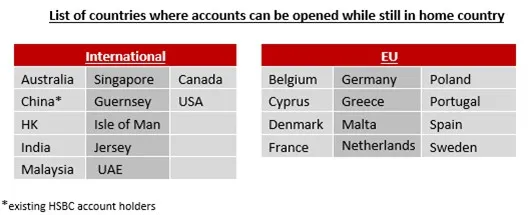
According to Icon Relocation, assignees living in the approved countries can provide proof of their overseas address. HSBC and Barclays Bank will continue to support other assignees once they have arrived in the UK without the need for proof of a permanent UK address.
Reminder of Documents Required
- Proof of identity document, e.g., passport.
- Address verification document for one’s residential address in the UK or overseas. HSBC can accept a letter from one’s employer that must be from a member of the HR team, issued on UK company letterhead, and include employment dates. The letter must also include a UK address if known or an overseas address if the UK address is unknown or not yet confirmed.
- Salary verification may be required.
- Verbal disclosure of Tax Identification Number.
NEI and our global service partners will continue to provide clients with updated information on this topic and others as they arise and to manage relocating employee expectations accordingly.
If you would like to discuss this visa and immigration situation further, please reach out to your NEI representative or Mollie Ivancic, NEI’s VP, International Services.
This material has been prepared for informational purposes only, and is not intended to provide, and should not be relied on for, tax, legal or accounting advice. You should consult your own tax, legal and accounting advisors before engaging in any transaction.
The first half of 2023 is behind us...
...But there’s much economic and real estate market uncertainty going into the second half for renters and homeowners. How will this affect global mobility and relocation services?
Real Estate Market Tug of War
Lawrence Yun, Chief Economist, National Association of Realtors (NAR) recently captured the changing real estate market conditions succinctly: “The market is clearly turning.”
Yet demand is not diminishing with the scarcity of single-family homes and there’s only a three-month supply of existing inventory. Add on to that, one-in-seven homeowners refuse to sell due to current mortgage rates. This puts continued pressure on rising home prices.
“Home price trends are caught in a tug of war between stretched buyer budgets and limited inventory forcing competition despite reduced affordability,” said Danielle Hale, Chief Economist for Realtor.com.
What can be done to help relocating employees with this issue in 2023 and 2024?
Good News / Bad News: First Time Homebuyers
While lower home values could hurt sellers, any listing price drops may entice buyers to submit offers – especially Millennials who rent. This is especially true for the record number of American renters who are spending at least one-third of their income on rents, according to Harvard’s Joint Center for Housing Studies.
However, paying a lower home purchase price and then having to finance it with a high interest rate can seem like “good news/bad news” to first time home buyers. In Q2 2023, the share of all prospective buyers who are in the market for the first time dropped to 61 percent, down from 71 percent in the first quarter per the National Association of Home Builders.
New construction has become an alternative solution for some frustrated buyers. Sales in the $200,000-$300,000 range for new builds surged in May 2023 to 12,000 new home builds sold, compared to May 2022 when only 5,000 sold. With that in mind, 51 percent of all housing market construction in Q1 2022 was for high-cost / luxury rental units and this shift towards higher-cost rental units has been observed through Q1 of 2023, per Moody’s.
Companies can help renting relocating employees who wish to become homeowners. NEI sees more companies now offering reimbursement of destination home closing costs and direct-billed mortgage partner assistance to relocating renters.
Another method companies can use to help recruit critical talent to needed locations is to offer homebuyers funds towards new home down payments or other incentives in the form of forgivable loans that don’t have to be paid back unless the employee leaves the company within a certain period, perhaps two or three years.
High-Rate Environment Drives Corporate Relocation Assistance
There are limited incentives for homeowners to give up their low mortgage interest rate when securing a new 30-year fixed mortgage since the average rate now sits in the seven percent range - over double the average rate during the pandemic.
Fed Chairman Jerome Powell was watching the unfolding situation carefully: “Housing is very interest-sensitive…it’s one of the first places that’s either helped by low rates or held back by higher rates.”
With possibly one or two more Federal Reserve rate hikes expected this year, consider the following options to help employees/candidates consider a company-sponsored move in such a high-rate environment:
- 3-2-1 Interest-Based Mortgage Subsidy
An appealing option for companies to consider is a subsidy program that supports mortgage payments over a set period to help the employee ease into the higher mortgage payment.
Many companies use a three-year period with the subsidized rate decreasing each year until the company would no longer subsidize interest. For budgeting, some prefer to define a maximum subsidy dollar amount spent per year for the benefit.
- Mortgage Interest Differential Allowance (MIDA)
MIDA was developed as a solution to assist employees purchasing a home at a significantly higher interest rate. Eligibility is based on if a specific interest rate threshold is passed (e.g., 7.5 or 8 percent with at least 2 percent differential on the employee’s existing mortgage). The company would temporarily pay the difference in interest between the employee’s former mortgage rate and their new one, for a set amount of time. The MIDA is sent to the lender and reflected on the employee’s payment.
Some mobility policies require employees to invest their full equity from the sale of the old home into the new home’s purchase to be eligible and maximums are sometimes placed on the total differential.
- Prepaid Interest
Companies can pay for loan discount points to assist relocating employees facing higher rates on a home purchase. Discount points are paid up front in exchange for a lower interest rate over the life of the loan.
Some mobility policies have a sliding scale for points coverage tied to the current market rate. If using a sliding scale, it may make sense to lower thresholds. Companies may offer to pay for one point when rates reach seven percent, two points at eight percent, and so forth. Thresholds help keep pace with changing rates and make moving more agreeable. Because this benefit impacts the life of the loan, this may not be the best option for an employee who could be relocated again within a few years.
Few Economists Expect Housing Crash
Predictions about a housing market crash create headlines, but few economists expect a nationwide decline like 2007-2009. Consider some big differences today:
- There are simply not enough homes to meet current demand and the country ultimately needs 4.3 million more homes, according to a Zillow analysis.
- Most homeowners with a mortgage today have great credit, significant home equity and a low rate. Housing prices in October 2022 were 38.1 percent higher than they were at the start of the pandemic in March 2020, per Fortune.
- About 90 percent of U.S. mortgaged homeowners have an interest rate below 6 percent, a Redfin report showed. 62 percent have a rate below 4 percent and nearly one-quarter have mortgage rates below 3 percent.
- Home value increases or decreases are more impacted by location today as compared to nationwide 15 years ago. Western U.S. home values have been hit particularly hard.
- Finally, we have strong consumer demand today and unsold inventory sits at a 3.1-month supply. “There are simply not enough homes for sale,” said Lawrence Yun of NAR. Realtor.com reported home sellers were less active in June 2023 with 25.7 percent fewer homes newly listed for sale compared to 2022.
For comparison, there was an 11-month supply of inventory in June 2008, interest rates were 6.32 percent, and 33.8 percent of homeowners were in a negative equity position. Since then prime mortgage requirements have become significantly tighter.
Unpredictable Markets, Proactive Relocation Services
The U.S. may likely end 2023 with higher short-term interest rates, but Moody’s Analytics Chief Economist Mark Zandi anticipates housing affordability will improve over the next few years, as reported in Fortune magazine.
Zandi feels rates will drift towards 5.5 percent in 2025 and national home prices may fall around eight percent, but "In our thinking this [price] weakness plays out over the next three years, there's no cliff event here, it's more of a slow grind lower," Zandi told Fortune.
NEI proactively counsels relocating employees about the emotional ups and downs when buying/selling a home and during the necessary negotiations, and we help clients brainstorm solutions. NEI monitors market and economic conditions to proactively discuss various options with clients, so client recruitment and retention goals are achieved.
For more information on the above or other needs or to discuss in more detail, please reach out to your NEI representative.
This material has been prepared for informational purposes only, and is not intended to provide, and should not be relied on for, tax, legal or accounting advice. You should consult your own tax, legal and accounting advisors before engaging in any transaction.
International Assignment Mentor Program Benefits
Designing an effective mentor program in the home country for employees returning from an international assignment can greatly benefit employee retention.
Aiding The Competition
Sometimes, the “larger cost” of an employee’s international assignment may only be felt when they resign from the company after repatriation due to feelings of being unappreciated or underutilized.
Consider “Gustavo”, who completed an exciting two-year assignment in Latin America. Upon repatriation to his home country, he was relegated back to the same position he held before leaving. His managers didn’t know how to use his new skills and envious colleagues teased that his assignment looked more like a paid vacation.
He felt like his new professional growth and knowledge from the assignment counted for nothing, so he accepted a position with a competitor that valued it. Now, his old company competes against Gustavo daily - having paid for him to gain the valuable international experience.
“The employee sees the assignment as a passport to promotion,” writes Benjamin Bader, co-author on a repatriation study, “but the employer wants someone to get the job done and is not making any promises.”
Sadly, Gutavo’s situation above is not an exception: according to a report by Deloitte, 71 percent of employees who leave a company within two years of an international assignment think their leadership skills were not being fully appreciated.
Mentorships Make an Impact
What can be done to reduce such unfortunate and costly post-assignment situations? Best practice assignment repatriation strategies to retain talent can include:
- Planning and discussing expectations of post-assignment career possibilities.
- Helping counter reverse culture shock, boredom, and re-adjustment difficulties.
- Maintaining strong, regular communication to remain connected to the corporate office/team while on assignment.
- Requiring home leave visits to the home country office to stay connected and consider post-assignment roles, rather than unrestricted home leave benefits to any location.
- Conducting assignee career planning at least eight-to-ten months before their repatriation.
A missing, often overlooked option towards maximizing one’s Return on Investment is a low cost / high value international assignment mentor program that can improve the likelihood of repatriating employees hitting the ground running after repatriation and staying with a company long term.
Consider these remarkable corporate mentor program statistics:
- Ninety percent of workers who have a mentor report being happy in their job and 71 percent of people with a mentor say their company provides them with good opportunities to advance in their career, per a CNBC/Survey Monkey report.
- Employees who are involved in mentoring programs have a 50 percent higher retention rate than those not involved, per MentorcliQ.
- Millennials intending to stay with their organization for more than 5 years are twice as likely to have a mentor than not (68% vs 32%), according to a Deloitte survey.
- Since the pandemic, there has been a 30 percent increase in mentoring initiatives at organizations, according to talent solutions provider LHH.
- 89 percent of those who have been mentored will also go on to mentor others, according to the firm McCarthy Mentoring.
After all, having someone who has been through an assignment and repatriation – and knows the inner workings of the organization can prove invaluable.
A Structure for Success
It is critical to get employees on assignment thinking about “post-assignment life” well in advance of repatriation.
It has repeatedly been shown how important it is for employers to recognize and validate returning assignees' new “international identity” by giving them opportunities to use their skills learned on assignment for their employer.
Home country mentors can add a personal touch -- based on their own, previous repatriation experience and going through a similar transition. Consider the following steps to develop a program by starting small and building up the programs over time:
1: Define objectives.
Make program goals realistic so they are obtainable. If there’s too much formality, the mentor programs risks being seen as the company pushing a “feel-good directive” and it might turn people off from participating if it’s seen as more work with no direct benefit.
2: Keep it simple.
A successful home country mentor program could start with a small pilot program that includes a handful of employees going on assignment and mentors who have been through the process. Programs that take a proper amount time to gather the appropriate volunteers and budget, while piloting a small-scale effort, will succeed more often before engaging in company-wide home country mentor program.
3: Identify and pair mentor cadres.
Finding willing mentors may prove a challenge. Opinions diverge on the best approach to forming each mentor-employee connection. Some firms use an application and interview process while others let employees on assignment choose from a pool of approved mentor names. A good mentor is like a good coach who asks the mentee probing questions based on their repatriation experience to help them transition back and discuss potential expectations, challenges, and opportunities.
4: Choose desired training approaches.
Formal, informal or hybrid training? No matter the approach selected, a mentee should be asked up front what they want to get out of such a mentorship program.
5: Setting clear and realistic expectations.
Setting clear expectations upfront in writing and counseling each assigned mentor-employee pair about your company’s vision for the program is key, as is the program’s expected timeline, personal boundaries, and the need for confidentiality between parties. HR should make clear to all involved that the mentor’s role is not to help secure the repatriating employee a new position or advocate for them before they return. Ultimately, that is commonly the employee’s responsibility at most companies today.
6: C-suite buy in for the program.
Finally, having buy in for an assignee mentor program initiative from one’s C-suite on down the chain of command is imperative. As noted in Success Magazine: “If you start a mentorship program that does not involve the C-suite, it will fail. Senior management should be heavily involved in setting guidelines, actions and goals for the program.”
Executives can also host quarterly, small group virtual sessions with company employees on assignment “so protégés can benefit from their wisdom and insight – without the tinge of favoritism that could otherwise arise” if they were to act as direct mentors themselves.
Challenges and Opportunities
One may think people would embrace the opportunity to become a mentor to others, but there are challenges to consider for attracting mentor candidates. These can include time, interest, and motivation:
- Time: In an already time-starved business environment, who has the time to oversee this program is one consideration, but even the most motivated mentors may defer from participating if they’re already too busy and it’s not part of their core objectives.
- Interest: The best mentors are those who have volunteered (not “voluntold”), who get satisfaction from helping colleagues, and who have themselves also had international assignment experience. According to Jan Rose of Capital H Group, in Chief Learning Officer magazine: “People lose interest…People lose track of what the program is supposed to do…Mentoring program failure might occur because the program’s goals are either fuzzy or they’re all over the place.”
- Motivation: If a corporate culture is ultra-competitive internally or there may be concerns about future downsizings, mentors may not want to coach their fresh-off-an-assignment colleagues.
For employees who have concerns over the above attributes, but the right past experience to help an assignee, there are additional perks mentors experience beyond helping a colleague.
It is found that employees who mentor typically raise their visibility within the organization and expand their personal network of contacts and mentors are 6 times more likely to be promoted, according to stats compiled by the Human Resources department of Sun Microsystems, writes Anne Fisher of Fortune Magazine.
Mentorships today also don’t need to be down the hall, in the same building or even the same country. Mentoring can be done via phone, Zoom, FaceTime, Teams, or email.
Finally, “Tapping into a mentor’s knowledge doesn’t have to be a person who is older. We live in an era that, in a few years, over 50 percent of Americans will have a boss who is younger than them,” says author Chip Conley.
Better Than Finding Qualified Replacements
Ideally, the importance of “life after repatriation” would be discussed with the employee at the same time they accepted the assignment and, six months prior to returning. The company would distribute the employee’s information to divisions and company hiring managers with open positions that would complement the employee’s experience.
Combined with this approach, mentor programs are highly effective to make employees feel supported before, during and after assignments. Though they seem easy on paper, internal planning and oversight for ongoing success and sustainability is key. It is a low-cost effort that can differ greatly by organization, but mentorship programs can make a lasting, positive impact on employee satisfaction, retention, and company ROI.
For more information, please contact your NEI representative.
Expert Home Pricing for Corporate Relocation
In the fast-paced arena of global mobility, swift and efficient property sales are critical for seamless relocations. Partnering with a relocation management company, like NEI Global Relocation, which vets top-tier real estate agents for their relocation related experience can help expedite moves.
John D'Ambrogio of @Properties is one such relocation agent and explains why proper pricing for relocating families is so important.
The Parade Only Passes by Once
In real estate, timing is everything. The parade of potential buyers passes by just once. When a property is freshly listed at the right price, it captures the attention of a vast pool of potential buyers. However, delays or mispricing can lead to minimal exposure, longer time on the market, and missed opportunities for relocation managers.
The Power of Proper Pricing
Today's buyers value precision. Overpricing a property can deter them. The National Association of Realtors states that pricing a property correctly appeals to 60 percent of buyers, but just a 10 percent overpricing reduces this figure to 30 percent. This reinforces the need to offer competitive and fair corporate relocation services.
Timing Matters in Real Estate and Relocation
Timing is pivotal in both real estate and relocation. Seasonal variations significantly impact outcomes. Just as summer is the peak season for home sales, winter tends to be slower. Choosing a reputable relocation management company with a service partner network of quality agents can help you adapt pricing and strategies accordingly to ensure efficient transitions.
Conclusion
Successful pricing for relocation hinges on selecting the right partners and understanding the critical role of timing. If you're seeking a partner with a track record of professionalism and delivering exceptional results in corporate relocation services, don't hesitate to reach out to NEI Global Relocation.
Top Global Mobility Risk Mitigation Challenges for Corporate Relocation
International assignments are integral components of many companies’ global growth strategies, but with such global growth comes risks that can keep corporate mobility managers up at night.
A Dynamic Global Mobility Landscape
The landscape of global mobility risk is complex and filled with potential potholes on the road to an employee’s successful international assignment. Political instability, security concerns, and/or health and safety issues are some of the top challenges employees and their sponsoring employers may face.
Addressing issues surrounding corporate global relocation risks requires a proactive, honest, and detail-oriented approach. It is critical corporate managers overseeing employee international assignments are knowledgeable and empowered from within and form close, collaborative partnerships with experts. This will help them navigate hazards with confidence and ensure the well-being of their employees and the duty of care obligations of their employers sending them.
Consider the top risks and ways to mitigate them:
Security
Terrorism, crime, geopolitical tensions –each pose unforeseeable dangers. Progressive companies will implement comprehensive security assessments and threat analysis to identify vulnerabilities and develop targeted risk mitigation strategies. Employee training on situational awareness, personal safety protocols, and emergency response procedures should be conducted. For clients, leveraging cutting-edge technologies such as online dashboard “heat maps” to show company employee / business travel assignment locations and cybersecurity protocols enhances online security to monitor and respond to potential threats in real-time.
Political Instability
To address political instability, global mobility managers must see the importance of staying ahead of political risks. They build networks of local partnerships and leverage geopolitical experts to gain valuable insights into the countries and regions where employees are assigned. By developing crisis contingency plans and protocols, they can respond quickly to political shifts, ensuring the safety of employees and the continuity of operations.
Health and Safety
Pandemics, natural disasters, employee medical conditions, on-assignment emergencies and more demand meticulous preparation. Proactive risk management involves developing crisis response plans, integrating remote monitoring systems, and ensuring access to telemedicine. By conducting pre-assignment medical assessments, organizations can identify any pre-existing health conditions and provide continued, appropriate on-going assignment support and resources. There are also options available for medical insurance coverage to consider such as:
- Employer-sponsored health insurance: comprehensive plans for employees provided with employment; covering medical expenses. Includes check-ups, emergencies, hospitalization, and dental/vision.
- International private health insurance: individual plans for global medical expenses; covering inpatient and outpatient services, emergencies, and medical repatriation.
- Travel insurance: May provide limited coverage for emergencies, accidents, and medical repatriation, but there is usually a limit for travel insurance policies and how long one can be living in a foreign location; companies should understand all policy limitations.
Crisis response and emergency evacuation plans are often overlooked in the overall planning of a move, but doing so is essential. Doing so during a crisis is not the time.
Regularly monitoring and checking in on employees’ well-being on assignment – regardless of their location – is also best practice and NEI regularly checks in with employees during their assignments for clients.
Collaborative Relocation Services Partnerships
By forging strong, mutually supportive partnerships with NEI Global Relocation, risk consultants, expert global security firms, global emergency evacuation companies, as well as local authorities, companies will gain access to invaluable expertise and worldwide resources.
Sharing best practices through industry collaborations and information-sharing networks further strengthens risk management efforts. Engaging in 24/7 open lines of communication with employees creates a culture of safety and empowers employees to be active contributors in risk mitigation.
Collaborative partnerships also foster a sense of mutual support and shared objectives among global mobility stakeholders. By combining resources, knowledge, and expertise, companies can effectively address complexities surrounding global mobility risks and strengthen both their operations resilience and the well-being of their employees during a global assignment on the company’s behalf.
Global Relocation Duty of Care Responsibility
As organizations expand around the world and send employees to locations for permanent work or temporary projects, each employer has an obligation to safeguard their mobile workforce. The Duty of Care concept includes a legal, ethical and moral obligation to reduce risk and provide the elements for a safe environment for employees during their global relocations or assignments.
By prioritizing Duty of Care, companies can demonstrate their commitment to not only individual employee / family welfare, but a commitment to conducting thorough risk assessments, implementing proactive security measures and developing robust health and safety protocols. Integrating Duty of Care principles and strategies into risk mitigation strategies, companies can foster a culture of employee safety and well-being.
Transform Risk into Opportunity
NEI believes risk management is essential for protecting both employee and company interests and for navigating the complexities of global mobility.
Organizations can transform risks into opportunities for growth, innovation, and sustainable success. By embracing risk management and mitigation practices, HR professionals can steer through the various, fluid challenges of international moves and assignments with confidence and help ensure the success of their organizations’ goals and projects.
If you would like to discuss policy change, risk mitigations or duty of care or any other topic impacting your global relocation programs, please reach out to your NEI representative.
Car Rental Costs Impacting Relocation Budgets
Current car rental costs remain far above pre-pandemic prices with no relief in sight for the foreseeable future due to consumer demand and vehicle availability. This is directly impacting relocation services and global mobility travel budgets.
Stubbornly High Costs
Airfare and lodging prices are still near all-time highs with flights five percent more expensive than in May 2019. Hotels are up 15 percent over the same period, according to a May 2023 report from the Bureau of Labor Statistics (BLS). Yet, when estimating talent mobility travel budgets for home finding and temporary living benefits, renting car costs may be the most surprisingly high factor.
The typical cost of renting a car in the U.S. increased 48 percent since May 2019, according to data from the BLS, so a rental that was $100 per day four years ago would now cost almost $150 per day.
It’s been two years since the initial price rise in the spring of 2021 and what some have called “the rental car apocalypse”, so why does this situation persist today?
Supply, Demand and Profits
Some say the reason prices have soared is simple:
- Supply
- Demand
- Record profits
Higher car prices severely impacted supply: rental car companies couldn't stock their fleets as fast as in the past due to supply chain issues and microchip shortages. Though fleet inventories finally grew again in 2022, they still have a long recovery to fulfill pent-up demand after companies sold off massive portions of their vehicle inventories to offset bleak demand during the pandemic. Consider that the Avis Budget Group alone sold 250,000 vehicles in 2021.
After the pandemic, demand skyrocketed as more people travelled in general, tourism activity and in-person business trips have approached pre-pandemic.
Finally, there was the issue of profits: some rental car companies had their best profit and revenue years and seek to make up for the lost years of the pandemic. Consumers continue to show a willingness to pay more to get around, so they are not inclined to reduce costs soon with continued high consumer demand.

Relocation Impact and Options
While the auto rental market may seem a small piece of a complex permanent move or international assignment, consider the times relocating employees / families may need to rent a car:
- For orientation /home finding trips to the destination to explore the new community
- When vehicles are needed at the departure location while relocating families’ cars are also being shipped to the destination
- When individuals inbound from another country may not be able to purchase an auto upon arrival in the destination
To contain costs, NEI Global Relocation Account Executives proactively guide relocating families in coordinating all schedules to minimize additional costs associated with such waiting periods.
Further, to make the best of the personal or professional travel situation, one might consider the following suggestions by NerdWallet to find available vehicles at the lowest prices:
Consider ways to avoid driving altogether. Public transportation, especially in large cities, can significantly reduce the cost of a trip.
- Check out alternatives to traditional rental car companies. Turo, Getaround and Audi on demand all offer different pricing and rental models, which could save money.
- Make smart shopping choices. Not all rental car companies have the same prices, nor do all locations. For example, renting a car at the airport is 26 percent more expensive than a downtown location, according to a NerdWallet analysis of 360 rental car reservations to better understand the cheapest ways to rent.
Among the rental car companies in the analysis, Enterprise was often the cheapest, while National was often the most expensive. It also found that last minute rentals are typically cheaper than those booked months in advance, and one may almost always save by booking at an off-site rental car location versus at the airport.
NerdWallet also recommends using a search engine that compares several rental car companies to obtain the best rate. However, make sure the final price includes all taxes, fees, and insurance costs needed.
Last, but not least, don’t over-pay for coverage that might already be provided through your credit card benefits.
Freedom to Get Around
It is believed rental car prices might come down later this year or early next. However, we’ve heard this before and statistics regularly show people are traveling for pleasure and business today more than ever and making up for lost travel opportunities due to the pandemic.
Renting a car can be a rewarding experience – allowing for independence and freedom – but stress and relocation costs can be minimized with proactive awareness. NEI consistently works with our clients to discuss the most cost-effective options available.
If you would like to discuss this or other relocation / travel policy trends or cost-saving solutions, please reach out to your NEI representative.






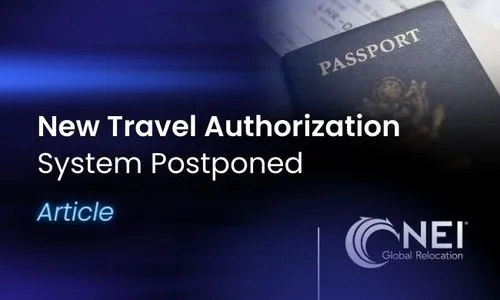
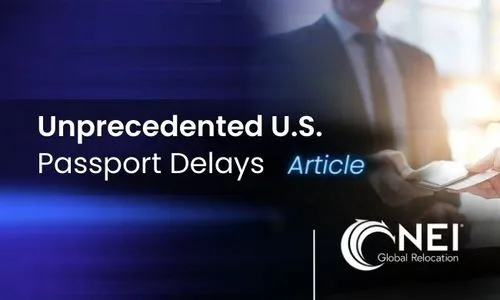


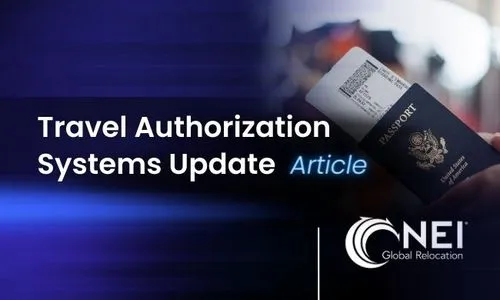










.webp)


